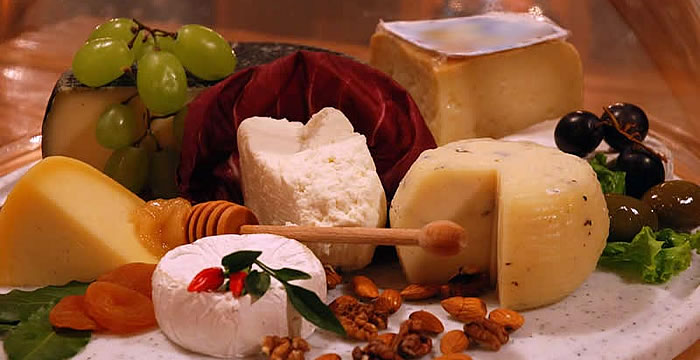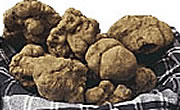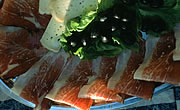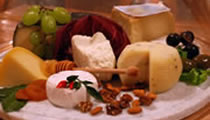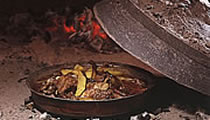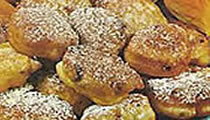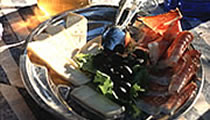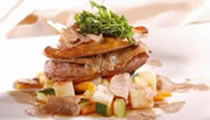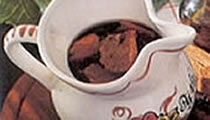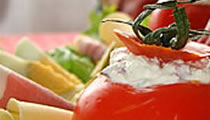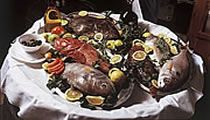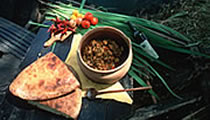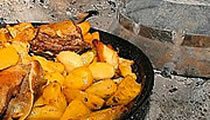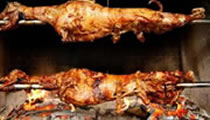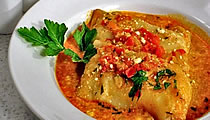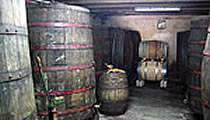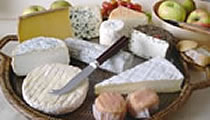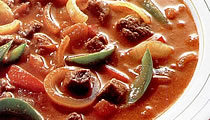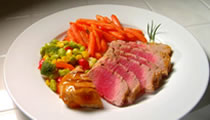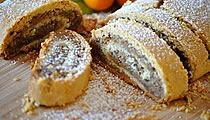Národní jídla a nápoje
Restaurace v Chorvatsko!
Co si dát k jídlu?
Co si dát k pití?
Tradični jidla pro ruzne priležitosti
Mnohe chorvatske tradični slavnosti jsou vyrazne spojeny s jidlem, bez ohledu na to, zda souvisi s naboženstvim (prevažne katolicke svatky: Vanoce, Velikonoce, poute, oslavy dnu mistnich svatych patronu) nebo na nezapomenutelnych momentu behem života pojedince ( krest, svatba, narozeniny atd.). Nektere oslavy jsou verejneho charakteru, jako svatek dionizijskeho dne sv. Martina, ktery se slavi na farmach, ve vinnych sklipcich a v restauracich. Zatimco jine jsou temer vyhradne v rodine ( svatby, krtiny, Vanoce, Novy rok, Velikonoce atd.). Každy svatek ma sve typicke jidlo. Gulaš z veproveho masa a brambor se konzumuje na poutich a na veletrzich, Treska obecna se pripravuje na Štedry den a Velky patek, veprove maso se ji na Novy rok, koblihy jsou nedilnou současti oslav masopustu, na jihu pripravuji podobny kolać kroštule. Šunka a varena vejce se zelenou zeleninou jsou podavany na Velikonoce, zatimco za dezert jsou tradični kolače ( napriklad mazanec). Kulen v dobe sklizne, husa na den sv. Martina, zatimco krocan a jina drubež a sarma se podavaji na Vanoce. Na svatbe je velky vyber jidel a kolaču a cukrovi,jako jsou broskve, medvedi tlapičky, perniky a kobližky. Vetšine lidi jsou vždy oblibene jehneči pokrmy a selatko na rožni, ryby na grilu, kalamary na ruzne zpusoby, maso na grilu: ražniče, čevapčiče a michane maso, šunka a ovči syr, uzena šunka a čerstvy syr se zakysanou smetanou, rybi paprikaš, teleci... Pobrežni kuchyne : Istrie a Kvarner
Ruzne druhy syru a chladna jidla jsou istarske speciality. Istarska a Kvarnerska kuchyn predstavuje specialni druh chorvatske kuchyne: to je smes vnitrozemske a pobrežni. Tyto regiony jsou bohate vynikaji rybou a morskymi plody. Mezi nejcennejšimi druhy , ktere se nachazeji na severnim Jadranu jsou krevety, kalamary a koryši z Limskeho kanalu. Po vynikajici šunce- pršutu se syrem a s olivama, tradični vinne sklepy nabizeji rybi polevku, rybi gulaš, varene krevety, bily a černy rizoto s morskymi plody a jine pokrmy typicke pro centralni častu istarskeho poloostrova – tradični vino "supica", polevka podobna italske minestrone ( "maništra","manestra" nebo "menestra"), testoviny a maso pripravene s dodanim slavnych lanyžu (tartufa), ktere jsou pestovane v teto oblasti. Reč je o velmi vzacnem druhu hub, ktere hledaji jen specialne vycvičeni psy a prasata. Predpoklada se, že tyto houby maji afrodiziakalni vlastnosti. Mezi vynikajici istrijanska vina patri Malvazija Buje, Cabernet Poreč, Souvignon a Merlot jako i Teran z Buzeta, Vrbnička zlahtina, šampanske Bakarska vodička atd. Dobre restaurace jsou na každem kroku v Istrii, zejmena v Opatiji, Crkvenici, Rovinju a v Poreči, take i ve vnitrozemi a na ostrovech. Pobrežni kuchyn: Dalmacie
Kuchyne Dalmacie a ostrovu navazuje na trend vyživy modenich norem. Jemne varene jidlo ( hlavne ve vode nebo na grilu) i mnoho ryb, olivovy olej, zelenina a divoke bylinky, ktere se nachazeni podel pobreži , jsou duvod, proč se tako kuchyn považuje za velmi zdravou. Dalmatinska vina, jako i olivovy olej a slane olivy, ceneny jsou z davnych dob, či dnešni nazvy druhu to odhaluji (Grk: z ostrova Korčula, Prc z osoka Hvara). K slavnym vinum parti Dingač a Pošip z poostrova Pelješac, Babić z Primoštena, Vugava a Plančić z ostrova Hvar... take Pošip a Grk z Korčule, Marastina z Lastova, Malvazija z Dubrovnika, atd., a taktež Prošek (slatko dezertni vino), velmi silne brandy a likery ( Maraskino, Vlahov). Although even today every area has its own way of preparing certain dishes, the cuisine of the islands represents a separate world, their distinguishing features having been discovered only recently, such as the cuisine of the islands of Hvar, Korcula, Brac (vitalac, a dish made from lamb offal wrapped in lamb gut and spike-roasted), Vis (spike-roasted pilchards, as during the Ancient Greek period; flat cake with pilchards from Komiza and Vis, related to the modern-day pizza). Fresh sea fish (dog's tooth, gilthead, sea-bass, grouper, mackerel, pilchards) grilled, boiled or marinated; then there are molluscs (squid, cuttlefish, octopus), crustaceans (shrimps, lobsters) and shellfish (mussels, oysters, date-shells) boiled in a fish stew or as a risotto. Of the meat dishes, prosciutto is unarguably unrivalled - pork leg smoked and dried in the bora (from Drnis), served with dry, mostly sheep’s cheese (famous sorts of cheese are those from Pag and Dubrovnik) and salted green and black olives, capers and pickled onions. Lamb is also very highly valued, especially boiled or baked on an open fire (Franjevacka begovica from Visovac, or lopiz from the island of Iz); also, dried mutton (kastradina), roast beef, Dalmatian stew (pasticada) with gnocchi, offered by many restaurants. Lightly boiled vegetables are also favourite dishes (Swiss chard with potatoes, tomato sauce) often a mixture of cultivated and self-sown vegetables, spiced with olive oil and wine vinegar, or served with meat (manestra - pasta with minced meat; Aramaic - stuffed vine leaves). Regions with an abundance of fresh water are famous for their frog, eel and river crab dishes (the Neretva valley, Trilj and the Cetina basin). Typical Dalmatian desserts win the heart with their simplicity. The most usual ingredients include Mediterranean fruit, dried figs and raisins, almonds, honey, eggs (rafioli, mandulat, smokvenjak, the gingerbread biscuits from the island of Hvar - rozata). Continental kitchen: Gorski Kotar and Lika
The cuisine of Gorski Kotar and Lika reflects living conditions in the forested highlands and pastures, where summers are short and winters long, which limits the availability of foodstuffs. It is recognized by its simplicity (open-fire cooking and baking), as is the case with regions closer to the sea (Dalmatinska Zagora and central Istria), but everyday meals include predominantly continental products - pura (or palenta) - boiled maize, boiled potatoes, or potato halves baked in their skin, pickled cabbage, broad-beans and runner beans, cow’s and sheep’s milk and delicious cheeses (fermented cheese known as basa, and dried cheese), meat, fresh and smoked lamb, mutton and pork, as well as venison. These regions are also rich in mushrooms and self-sown herbs, but there are also delicious, strong plum brandies and brandies made from forest fruits, or mixed with honey. The cuisine of Lika is found in the region of the Plitvice Lakes, and fine homemade cheese can be bought from roadside stalls when driving through Lika. Continental kitchen: Northwest Croatia
The cuisine of northwest Croatia is characterized by many simple, delicious dishes. Bread is mostly made from maize, barley, or a mixture of the two, and cakes are often similar in texture to bread (kukuruznjaca - made from maize; periaca, zelevanka, buhtli, doughnuts, walnut and poppy-seed loaves). A profusion of pasta dishes, dairy products (made mostly from cow’s milk), as well as plenty of vegetables (beans, potatoes, cabbage, etc.), often mixed with meat to form a broth (zucchini, cucumbers, runner beans, broad beans, peas in the summer, and beans with pickled cabbage in winter, beans with barley porridge) and salads (fresh cucumbers with sour cream and garlic, lettuce, tomato salad, peppers and onions). This is where food provision for the winter is still made in the traditional manner (pickled cabbage, cucumbers boiled in vinegar, pickled peppers, red beet, as well as sweet dishes - plum jam, rosehip jam, bottled fruit, etc.). In the same way that southern cuisine differs from island to island, so does the cuisine in this part of the country differ from one region to the next. In the region of Medjimurje one really must sample buckwheat porridge with meat from fat meat or blood-sausages, as well as side dishes of baked beans or potatoes, formed in cones, with rich spices, or smoked or dried cow’s cheese turas, known in the region of Podravina as prge. Turkey with mlinci (a boiled pasta dish), strudels of various kinds, as well as pumpkin cake with poppy seeds, have spread from the region of Zagorje throughout Croatia. It is hard to find more delicious geese and ducks than those from the region of Turopolje, or baked carp (krapec na procep) than those from the regions of Moslavina and Posavina. The region of Banovina became famous for its winter salami (Gavrilovic salami). blood-sausages, garlic-sausages and other special sausages, for baking with pickled cabbage, boiled smoked pork leg with potato or bean salad with onion, are favourite dishes almost everywhere. Samobor, a small town near Zagreb, is an ideal venue for a gastronomic excursion. Its picturesque restaurants offer Samobor Steak, Samobor custard slices, salami and kotlovina - port and potato stew - hermet (sweet, spicy wine) and mustards which have been prepared here for almost two hundred years. The cuisine of Varazdin, and in particular of Zagreb, represents urban, metropolitan cuisine, related to the more famous cuisine of Venice. Of course, Zagreb has also its steak (bread-crumbed veal stuffed with cheese), and it also offers a variety of roast dishes (beef, pork and fowl) served with potatoes, vegetables and horseradish, as well as various stews (wine goulash, bacon and tripe, lungs "sour art"), grilled meat, pasta… Delicious sweets continue a tradition hundreds of years old – a tradition of the "baking woman of Gric" and bishops’ pastry-cooks, revealing Croatian dessert cuisine in its entirety (Croatian pancakes, Zagorje strudel, strudel stuffed with cottage cheese, or apple strudel, bucanica, various cakes, ice-creams). Zagreb’s contemporary cuisine is international, with the finest Italian cuisine widely represented. Restaurants frequently offer better quality fish than those available on the coast, more delicious lamb than in the region of Lika, and better kulen than in Slavonia. One should savour the following wines from this region: Portugizac from Plesivica and Jastrebarsko, Rhine Riesling, Chardonnay from Strigovan, Muscat Otonel, Turk's sparkling wines, as well as wines from the wine-cellars in Bozjakovina, Pinot Blanc from Sveti Ivan Zelina, Moslovina Skrlet from Voloder, as well as many other wines, but also the traditional drink, gvirc (gvirc, mead) sipped with gingerbread biscuits. Continental kitchen: Slavonia and Baranja
Slav Rich and fertile Slavonia and Baranja comprise the bread basket of Croatia, and so white bread, flat cakes and many other cakes filled with walnuts, with poppy seeds or plum jam, have been baked here since ancient times, made from the most representative pastry made from green wheat. Pasta, potato, beans, dairy dishes and fat meat dishes (cottage cheese with sour cream, dried cheese) and fattened fowl and pork dishes are also prepared here. Such types of food were once cooked to provide the energy required for heavy work, although these days their preparation is considered too time consuming, and requiring too much effort. In these regions hot goulash (beef, venison), regos (several meats with pasta), fish paprika-flavoured stew (with various fish: carp, pike, sheat-fish, etc.) are typical. Smoked and dried pork ham, sausages, as well as kulen are also firm favourites, especially when served as a delicacy with cottage cheese, peppers, tomatoes and green onions or pickled vegetables (tursija). The plum brandy made in this region is very smooth, and wines, such as Kutjevacka Grasevina and Kutjevo Chardonnay, the Rhine Riesling of Enjingi, and also the Grasevinas of Krautheker and Zdjelarevic, Ilok Thaminer, Pinot Blanc from Pajzos and Endent Riesling from Belje are greatly appreciated the world over. Wines from the wine cellars of the Djakovo diocese, famous for the production of wines used in liturgical services, are equally well known. |

